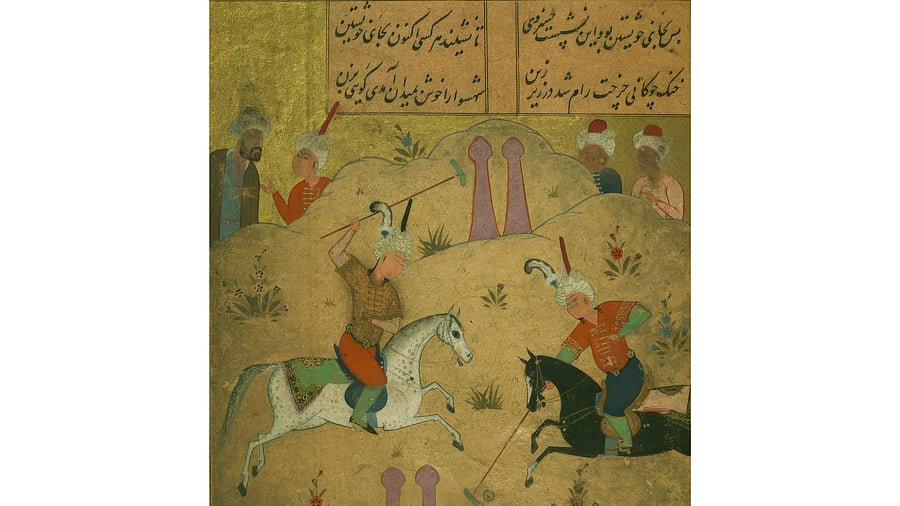
Polo game, safavid, ink and pigments on buff. (Pic courtesy: The Walters Museum, Maryland)
Krittika Kumari
Thundering hooves, riders swinging their mallets, loud cheers from the stand: the polo game is in full swing!
Polo has a long history. In South Asia, the ancient Meitei treatise, Kangjeiroi, dates the game to around 1400 BCE at the court of Ningthou Kangba, who ruled the ancient state of Kangleipak in present-day Manipur. In ancient Iran, an equestrian game akin to present-day polo was played as early as 600 BCE. In China, the game was played in the 7th century under the Tang dynasty. Traditionally, two teams with 16 horseback players on each side used sticks bearing crescent tips to hit the ball into the goal of the opposing team.
Since then, versions of polo have been played in various parts of the world — in China, Tibet, Myanmar, and more recently, in southern Africa and America. In the Indian subcontinent, it was played in the Gilgit-Baltistan region, Ladakh and Manipur; in Turco-Afghan and Mughal north India, in Rajput-ruled western India and in the Deccan.
Modern-day polo, with its very British associations, finds roots in the northeastern state of Manipur in India. In early modern Manipur, sagol kangjei, or horse hockey, was a popular royal pastime amongst Manipuri and Burmese royalty. Illustrated Burmese manuscripts, or parabaiks, from the 19th century, depict the game being played as part of important royal ceremonies and festivals. The paintings portray men on horses, mallets in hands, with members of the royal family watching the game. When Burma invaded Manipur in the 19th century, courtiers and locals fled to neighbouring territories in what is today Assam, where they continued to play the game. It was there, around the mid-19th century, that British tea planters and army officials took notice of it. The game was called polo, believed to derive from the Tibetan phulu, or ‘ball’. In the next few decades, multiple polo clubs were set up by British officials in Assam, Bengal, and elsewhere — the first was in fact formed in Calcutta between 1861 and 62 by two British army officials, Joseph Sherer and Robert Steward. The British originally played on small ponies, at a slow pace, with teams of eight players. As tournaments became more frequent, the game evolved to be played on larger horses. Polo reached Malta in 1868 and England in 1869, where it was adapted and modified into the four-player version that we know today. The Indian Polo Association was formed in 1892, and international rules were consolidated for the game after the First World War.
Equestrian sport had already been an important part of gentlemanly conduct amongst British officers in the 19th century, and this hard-paced, dangerous and expensive game became an integral pastime in India. After the First World War, polo symbolised a new era of British aristocratic and chivalric values. Today, the game is played in over 70 countries worldwide.
Discover Indian Art is a monthly column that delves into fascinating stories on art from across the sub-continent, curated by the editors of the MAP Academy. Find them on Instagram as @map_academy